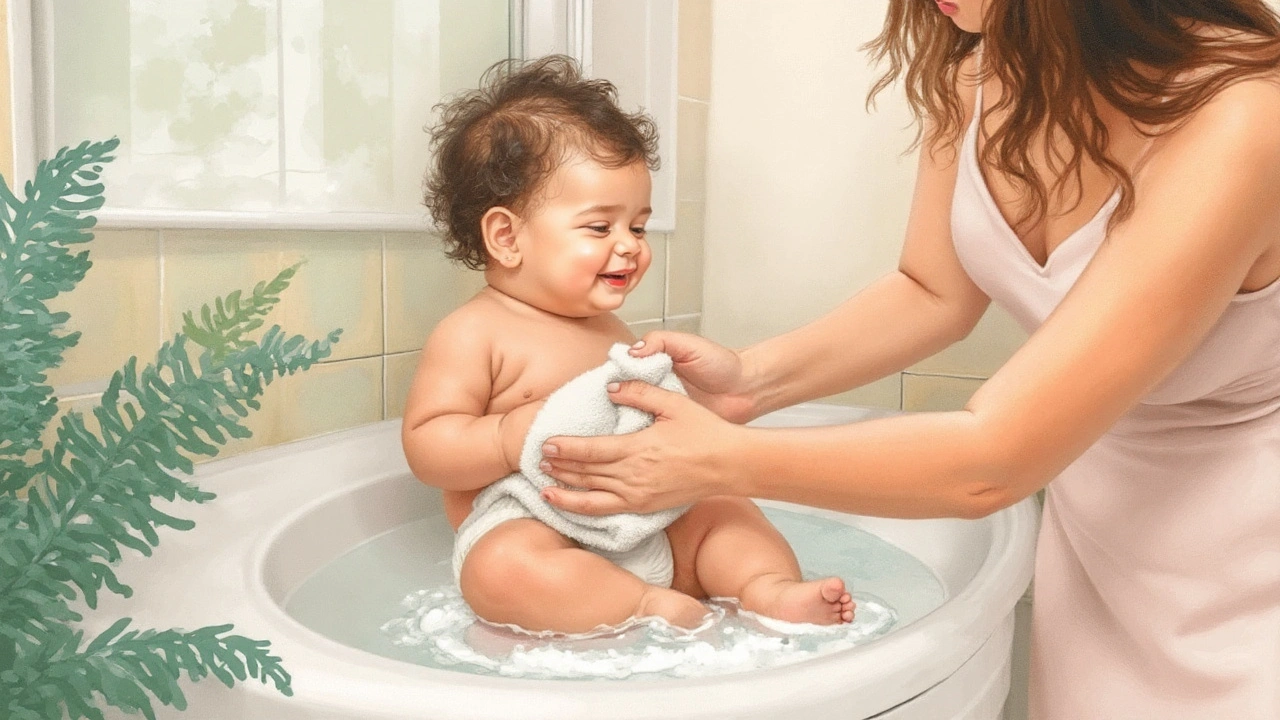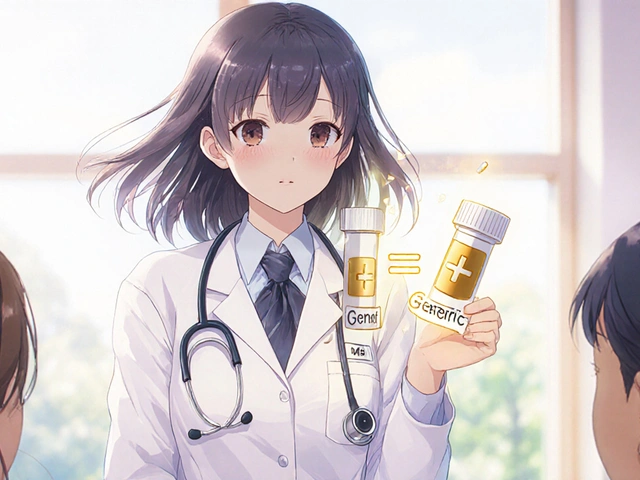
Sticky weather traps sweat and moisture under a diaper, and that can turn healthy baby skin into a red, stinging mess in hours. The good news: with the right routine, most heat-and-humidity rashes calm down in 24-48 hours and heal in a few days. This guide gives you a simple plan you can do at home, what products matter, how to prevent flare-ups in hot months, and how to spot when it’s more than just heat.
TL;DR: Fast Relief When Heat and Humidity Spark Diaper Rash
Here’s the quick plan that stops the sting and starts healing today.
- Rinse, don’t scrub: Use lukewarm water or fragrance-free wipes. Pat, don’t rub.
- Dry like you mean it: Fan or air-dry 1-2 minutes every change. Moisture is the enemy here.
- Thick barrier, every time: Zinc oxide 20-40% or plain petrolatum, on like frosting. Don’t wipe it all off each change-just the soiled layer.
- Change more often: Aim for every 2 hours while awake, and right after stools.
- Let skin breathe: Loosen the diaper. Give 10-15 minutes of diaper-free time 2-3 times a day.
- Overnight plan: Extra-thick barrier + a highly absorbent diaper to keep skin dry till morning.
- When to adjust: If rash is beefy red in the folds with “satellite” dots, add a thin layer of clotrimazole or miconazole twice daily for 7-10 days.
- What to avoid: Powders (talc), fragranced products, and topical anesthetics like benzocaine.
- See a doctor if: Fever, blisters, oozing, yellow crust, spreading beyond diaper, or no improvement after 2-3 days of solid care.
Expectation check: Most heat-triggered rashes start looking better within 24-48 hours once you control moisture and friction. Full healing often takes 3-5 days.
Step-by-Step Care: From First Change to Overnight
Heat and humidity don’t just “irritate” skin; they set up a perfect storm: sweat + trapped moisture + friction + ammonia from urine. The fix is simple: clean gently, dry well, protect thickly, and reduce heat.
-
Reset the skin
- Do a quick lukewarm rinse in the sink or with a squeeze bottle. If you’re out, use a soft, fragrance-free wipe. Don’t scrub-rubbing worsens microtears.
- Pat dry with a soft cloth. Then fan or air-dry for 60-120 seconds. If you see shiny moisture, it’s not dry yet.
-
Lay down a real barrier
- Use zinc oxide 20-40% or plain petrolatum. Aim for a frosting-thick layer you can see. If you can read skin through it, add more.
- Heuristic: if stool sticks to the skin, the barrier was too thin. Next change, go thicker.
- Don’t remove every bit of ointment each change. Gently wipe away only what’s soiled; leave the clean layer. Add fresh on top.
-
Change the pace
- Daytime: change at least every 2 hours in hot weather, and ASAP after stool. Night: use a high-absorbency diaper and a double-thick barrier layer.
- Loosen the diaper tabs to allow airflow. You want snug enough to avoid leaks, not tight enough to trap heat.
-
Air time
- Give 10-15 minutes of diaper-free time, 2-3 times a day. Put a towel under baby, or use a “diaper-free onesie” hack: diaper under, onesie snapped over to hold it loosely.
- Portable fans help, but keep airflow gentle and not directly blasting baby.
-
Target the cause pattern
- Simple heat rash: pinpoint red bumps, sparing the deep skin folds, worse after hot naps. Your main tools are drying + thick barrier + frequent changes.
- Yeast overlay (common in humid weather): beefy red, shiny, involves the folds, with small red “satellite” spots. Add a thin layer of clotrimazole 1% or miconazole 2% twice daily under your barrier for 7-10 days. Keep going 2 days after it looks better.
- Bacterial signs: yellow crust (honey color), pus, rapidly spreading redness, or pain out of proportion. That needs medical care-often a prescription topical or oral antibiotic.
-
Smart product choices
- Wipes: pick fragrance-free, alcohol-free. For bad flares, plain water and soft cloths are gentlest.
- Barrier: zinc oxide 20-40% for sore skin; petrolatum for daily prevention or minor redness. If the skin is weepy, zinc tends to stay put better.
- Diapers: in heat, breathable disposables often beat cloth for moisture control. If using cloth, switch to stay-dry liners and change more often.
-
What not to use
- No talc powders (inhalation risk; AAP advises against).
- No cornstarch on suspected yeast (it can feed Candida growth).
- No topical anesthetics like benzocaine or lidocaine (can irritate and carry safety risks in infants).
- No fragrance-heavy creams or wipes.
-
Short, cautious steroid use (if very inflamed and not yeast)
- A very thin layer of 0.5-1% hydrocortisone twice a day for up to 48 hours can help calm intense inflammation-then stop. Always put the barrier on top.
- If there’s no improvement in 2 days, stop and call your pediatrician. Don’t combine steroid + antifungal in one go unless instructed by a clinician.
Evidence notes: Pediatric guidelines from the American Academy of Pediatrics and dermatology reviews consistently point to frequent changes, gentle cleansing, and thick barrier ointments as first-line care; antifungals are added when yeast features show up; powders and fragrances are discouraged. A large Cochrane review has not found a single “miracle” product, but supports barrier ointments and simple routines as the most reliable approach.

Prevention That Works in Hot Weather: Gear, Habits, and Real-Life Examples
Once the rash is calming down, shift to prevention. Heat and humidity will be back tomorrow. Make your routine heat-proof.
- Rule of thumb: If the forecast heat index is high enough that you’re sweating in shorts, your baby needs an extra change cycle and thicker barrier that day.
- Use breathable layers: cotton onesies, no plastic diaper covers in summer, loose fit around thighs and belly.
- Set diaper-change anchors: after every feed, before car-seat rides, right after naps. Heat builds in car seats and carriers.
- Night strategy: high-absorbency diaper + thick barrier; consider a dream-change before your bedtime if your baby sleeps long stretches and is rash-prone.
- Daycare coordination: send your barrier ointment, ask for changes every 2 hours in heat waves, and provide scent-free wipes.
Here are common scenarios and how to handle them.
-
Long car ride on a 90°F day: Preload with a thick barrier, change just before you start, plan stops every 2 hours, crack windows or use AC to keep the backseat cool, and loosen the diaper a notch.
-
Park play in humid afternoon: Bring a wipeable mat for quick diaper-free air time under shade. After play, quick rinse, pat dry, barrier on thick.
-
Cloth diaper family: In heat waves, switch to stay-dry liners, add a booster to absorb sweat and urine, and consider a temporary move to disposables overnight until the flare passes.
Checklist you can screenshot:
- Switch to fragrance-free, alcohol-free wipes (or water + cloth).
- Barrier every single change in hot weeks, not just when red.
- Diaper-free air time: 10-15 minutes, 2-3 times daily.
- Change every 2 hours while awake; ASAP after stools.
- Loosen the diaper a notch; choose breathable clothing.
- Use a fan for gentle airflow during changes.
- Pack a backup outfit and extra diapers for heat days.
This quick reference table helps you match what you see to what you do.
| What you see | Likely trigger | What to do now | When to call the doctor |
|---|---|---|---|
| Redness on bum, spares deep folds; worse after naps | Heat + moisture + friction | Dry well; thick zinc/petrolatum barrier; change q2h; air time | No improvement in 48 hours |
| Beefy red, shiny, involves folds; satellite red dots | Yeast (Candida) overlay | Add clotrimazole 1% or miconazole 2% thin layer twice daily under barrier for 7-10 days | If not improving by day 3; if mouth thrush too |
| Yellow crust, pus, rapidly spreading redness | Bacterial (impetigo/cellulitis) | Stop steroid; keep clean and dry | Same day evaluation needed |
| Blisters, ulcers, fever, or baby very fussy with pain | Severe dermatitis or infection | Protect with barrier; no powders or fragranced products | Urgent care |
| Persistent rash despite routine, recurs often | Allergic contact dermatitis or technique issue | Switch to different diaper/wipes; review routine; consider hypoallergenic products | Dermatology or pediatric visit |
Data snapshot: Diaper dermatitis affects a large share of infants at some point in the first year, with peaks around 9-12 months. In hot seasons, clinics report more visits for rashes as humidity rises, and yeast features show up more often. Pediatric sources like the American Academy of Pediatrics emphasize barrier ointments, frequent changes, and avoiding powders; dermatology reviews add that clotrimazole or miconazole help when yeast signs appear.
If you remember one phrase, make it this: dry, protect, and breathe. That formula solves the heat-and-humidity rash most of the time.
FAQ and What to Do If It’s Not Getting Better
Here are straight answers to the questions parents ask in hot months, plus a simple decision guide if things stall.
-
How fast should I see improvement? Some relief (less redness, less sting) in 24-48 hours after you start drying well and using a thick barrier. If you’re seeing almost no change by day 3, involve your pediatrician.
-
Which barrier is better, zinc or petrolatum? Zinc oxide sticks to weepy, irritated skin a bit better and is great for active rashes. Petrolatum is slick, easy to spread, and perfect for prevention. Many parents use zinc for flares and petrolatum for maintenance.
-
Can I use breast milk on a rash? Evidence is mixed. Some small studies compare it to mild ointments with varied results. For heat-and-humidity rashes, proven barriers and frequent changes are more reliable.
-
Is hydrocortisone safe? A very thin layer of 0.5-1% for up to 48 hours can help if the rash is very inflamed and you don’t see yeast signs. Always put barrier on top. Stop if no improvement in two days and call your doctor.
-
What about probiotics? Not a go-to for this. Keeping skin dry and protected helps more. Use antifungal cream only if yeast signs show up.
-
Do I need to switch diapers? If the rash keeps coming back in heat, try a more breathable or more absorbent brand, or switch to disposables at night if you use cloth. Avoid plastic covers that trap heat.
-
Can cornstarch help? Skip it when yeast is suspected. It can encourage yeast growth. In general, ointments beat powders for diaper area care.
-
Are wipes bad? Fragrance-free, alcohol-free wipes are fine. During bad flares, water + soft cloth is gentlest. Pat-don’t rub.
Decision guide you can follow at home:
- If red and sore but not in the folds: Focus on drying, thick barrier, frequent changes. Expect improvement in 1-2 days.
- If beefy red in folds with small satellite dots: Add clotrimazole or miconazole twice daily under the barrier for 7-10 days.
- If yellow crust, oozing, or baby has a fever: Call your clinician the same day.
- If it’s not better after 2-3 days of good care: Get a medical review to rule out yeast, bacterial infection, or contact allergy.
Next steps by situation:
-
Newborn (0-3 months): Skin is thin and reactive. Use water + soft cloth, pat dry, and a zinc barrier. Avoid any steroid unless a clinician says so. Change at least every 2 hours in heat.
-
Toddler on antibiotics: Higher yeast risk. If yeast signs appear (folds, satellites), start clotrimazole/miconazole and continue 2 days past clear.
-
Babies with sensitive skin/eczema: Stick to simple formulas. Fragrance-free everything. Petrolatum for daily prevention, zinc for flares.
-
Daycare routines: Pack your barrier, label it, request changes every 2 hours on heat-advisory days, and send backup breathable outfits.
-
Cloth diaper users: Strip wash if you suspect build-up; use fragrance-free detergent; add stay-dry liners; consider a temporary disposable overnight in heat waves.
Red flags that mean you shouldn’t wait:
- Fever, blisters, or raw, bleeding sores.
- Rapidly spreading redness or baby in significant pain.
- Yellow crust or pus.
- Rash spreading beyond the diaper area.
- No improvement after 2-3 days of solid care, or constant quick recurrences.
Why this plan works: It targets the mechanics of heat rashes-moisture and friction-while covering common add-ons like yeast. Pediatric groups (including the American Academy of Pediatrics) and dermatology reviews back this approach: gentle cleansing, frequent diaper changes, and reliable barriers; add antifungal only when yeast features show up; avoid powders and fragrances. It’s not fancy, but it’s dependable.
If you want to label what you’re doing, this is evidence-based diaper rash treatment tuned for hot, humid weather. Keep the routine tight for two days, and you should see the sting fade and the skin calm down.





Comments (10)
mona gabriel
Dry, protect, breathe. That’s it. No magic creams, no fancy gadgets. Just stop trapping sweat like a plastic bag and let that skin catch a break.
Been there. Done that. With triple the humidity and a baby who screamed like a banshee.
Thick zinc oxide like frosting? Yes. Air time like it’s a spa day? Absolutely.
My kid’s rash vanished in 36 hours. Not because I’m a genius. Because I stopped overcomplicating it.
Heat doesn’t need a PhD to fix it. It needs space.
And patience.
And less wipes.
And more fans.
That’s all.
Stop buying $30 miracle balms.
Just let the air in.
Phillip Gerringer
Anyone who uses cornstarch on a diaper rash deserves to be reported to child services. It’s not just ineffective-it’s a fungal incubator. You’re literally feeding Candida with a spoon.
And if you’re still using talc? You’re not a parent. You’re a liability.
Zinc oxide 20-40% isn’t optional-it’s the baseline. Anything less is negligence.
And if your baby’s rash persists past 48 hours without antifungal? You didn’t read the damn TL;DR.
Stop winging it. This isn’t TikTok. This is dermatology 101.
jeff melvin
Barriers must be applied with surgical precision. You don’t dab. You frost. You layer. You don’t wipe off the old layer unless it’s visibly soiled.
And if you’re using cloth diapers in 90-degree heat? You’re asking for trouble.
Stay-dry liners aren’t a luxury-they’re a necessity.
Hydrocortisone? Only if you’ve ruled out yeast. Otherwise you’re masking the problem.
And please, for the love of God, stop using breast milk. It’s not a treatment. It’s a superstition with lactose.
Matt Webster
I just wanted to say thank you for writing this. I’ve been stressing for days over my son’s rash and felt so alone.
Reading this felt like someone handed me a flashlight in the dark.
My wife and I started the air-dry routine last night-just 10 minutes on the changing pad with the fan on low.
He didn’t cry once. Not once.
And this morning? The redness had already faded around the edges.
You didn’t just give me steps. You gave me hope.
Thank you for not making us feel stupid for not knowing this.
It matters.
Stephen Wark
Oh wow another one of those ‘just air it out’ posts. Like that’s gonna fix the fact that daycare won’t change him every 2 hours and the baby is in a car seat for 3 hours straight.
And don’t even get me started on the ‘use zinc oxide’ advice.
Have you seen the price of that stuff lately? I’m on a budget here.
Also my cousin used coconut oil and her kid was fine.
So maybe this whole ‘science’ thing is just corporate propaganda.
Also I’m tired. And it’s 95 degrees. And my baby won’t stop screaming.
So no. I’m not frosting his butt with zinc oxide.
And I’m not taking a fan to the park.
So sue me.
Daniel McKnight
There’s something deeply poetic about how a baby’s skin becomes a battlefield of sweat and silence.
Every change is a ritual. Every breath of air, a rebellion.
We think we’re protecting them with plastic and powder, but really-we’re smothering them in our fear.
The diaper-free time? That’s not a hack. That’s a homecoming.
Let them feel the breeze. Let them feel the floor.
Let them be naked and unafraid for ten minutes.
That’s not parenting.
That’s love in its most literal form.
And the zinc? That’s not cream.
That’s armor.
Wear it like a shield.
Not a suggestion.
Jaylen Baker
Just wanted to say-I followed this exactly. Every step. Even the 10-minute air time. Even the extra-thick barrier at night.
And guess what? It worked.
Like, shockingly well.
Day 1: Red, angry, screaming.
Day 2: Less red. Smiling during changes.
Day 3: Barely a trace.
My wife cried. I cried.
This isn’t just advice.
This is a lifeline.
Thank you for not just listing products.
Thank you for explaining why.
Because now I get it.
And I’m not scared anymore.
Fiona Hoxhaj
One must consider the phenomenological experience of infant dermatological distress within the anthropological framework of post-industrial parenting.
Our reliance on synthetic absorbents and chemical barriers reflects a broader epistemological rupture between natural bodily processes and technocratic intervention.
While zinc oxide may offer temporary epidermal occlusion, it does not address the ontological alienation of the infant from ambient environmental harmony.
Perhaps, instead of frosting the perineum, we ought to cultivate a bio-spiritual attunement to the child’s dermal rhythms.
And yet-
the pragmatism of the TL;DR is undeniably seductive.
One cannot help but wonder: is healing a matter of protocol… or of surrender?
Merlin Maria
Incorrect use of hydrocortisone is a documented risk factor for adrenal suppression in infants under six months. The guideline says 0.5–1% for 48 hours max, but you must also consider skin thickness, surface area, and frequency of application.
Also, if you’re using cloth diapers, you must strip them weekly with hot water and sodium percarbonate to prevent detergent buildup, which exacerbates contact dermatitis.
And no, breast milk does not have antimicrobial efficacy comparable to zinc oxide. That’s a myth perpetuated by Instagram influencers.
Also, the Cochrane review you cited doesn’t support ‘frosting’ as a clinical term. Please use precise terminology.
This isn’t a blog post. It’s pediatric care.
Do better.
Nagamani Thaviti
This is too much info and too many words why not just use coconut oil and be done with it